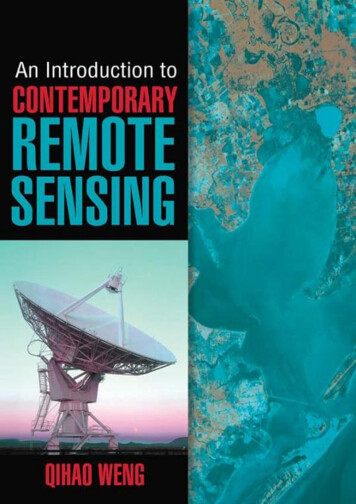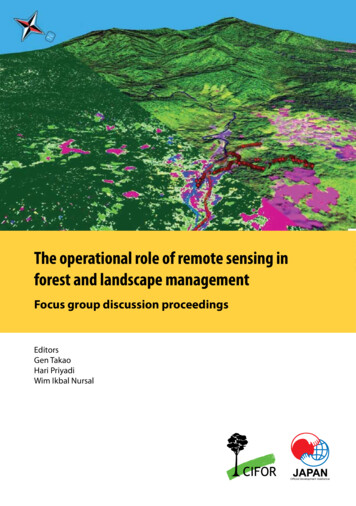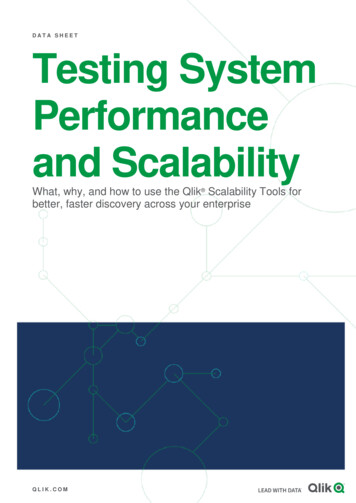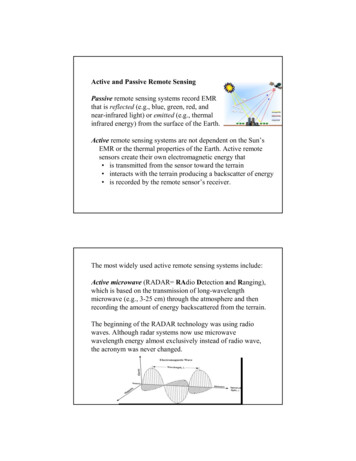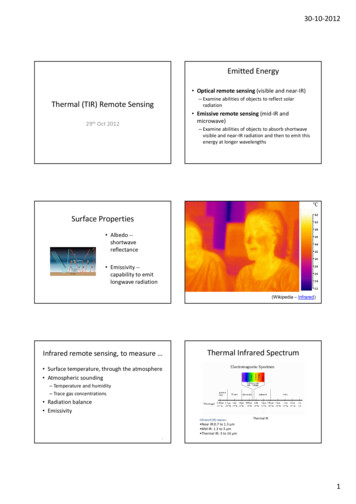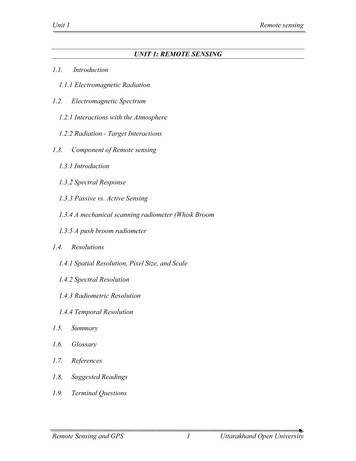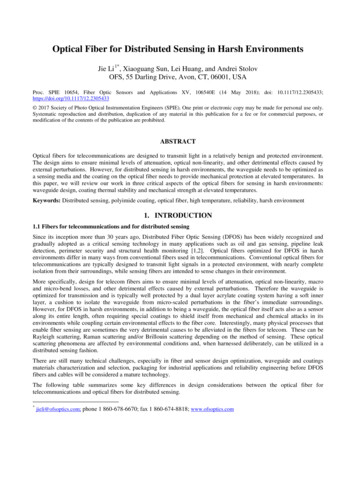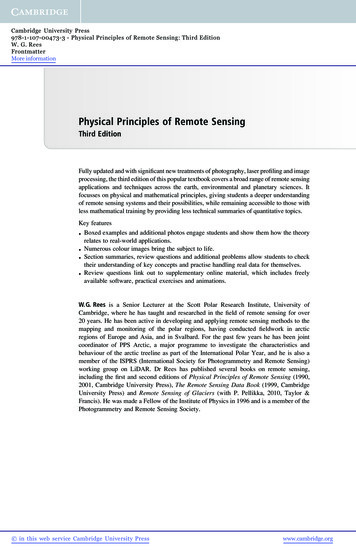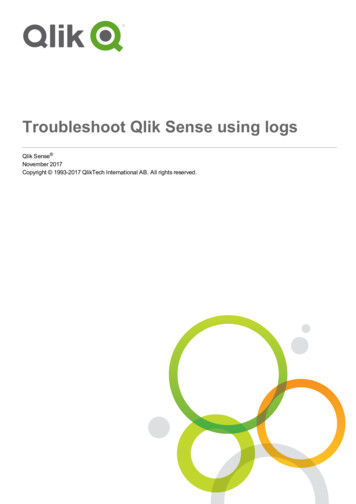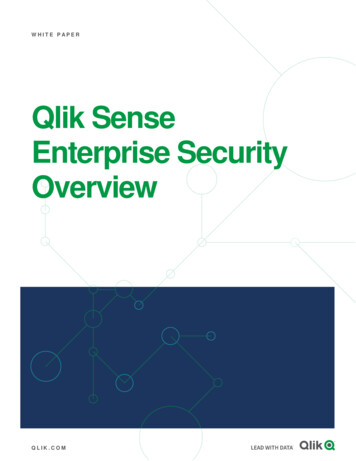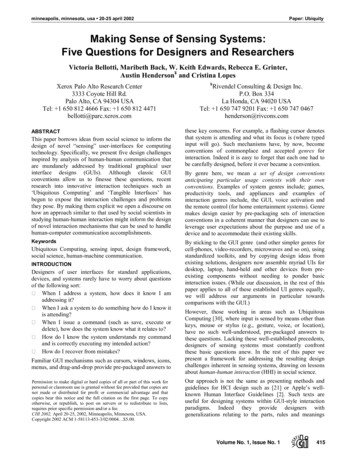
Transcription
minneapolis, minnesota, usa 20-25 april 2002Paper: UbiquityMaking Sense of Sensing Systems:Five Questions for Designers and ResearchersVictoria Bellotti, Maribeth Back, W. Keith Edwards, Rebecca E. Grinter,Austin Henderson and Cristina LopesXerox Palo Alto Research Center3333 Coyote Hill Rd.Palo Alto, CA 94304 USATel: 1 650 812 4666 Fax: 1 650 812 4471bellotti@parc.xerox.comABSTRACTThis paper borrows ideas from social science to inform thedesign of novel “sensing” user-interfaces for computingtechnology. Specifically, we present five design challengesinspired by analysis of human-human communication thatare mundanely addressed by traditional graphical userinterface designs (GUIs). Although classic GUIconventions allow us to finesse these questions, recentresearch into innovative interaction techniques such as‘Ubiquitous Computing’ and ‘Tangible Interfaces’ hasbegun to expose the interaction challenges and problemsthey pose. By making them explicit we open a discourse onhow an approach similar to that used by social scientists instudying human-human interaction might inform the designof novel interaction mechanisms that can be used to handlehuman-computer communication accomplishments.KeywordsUbiquitous Computing, sensing input, design framework,social science, human-machine communication.INTRODUCTIONDesigners of user interfaces for standard applications,devices, and systems rarely have to worry about questionsof the following sort:When I address a system, how does it know I amaddressing it?When I ask a system to do something how do I know itis attending?When I issue a command (such as save, execute ordelete), how does the system know what it relates to?How do I know the system understands my commandand is correctly executing my intended action?How do I recover from mistakes?Familiar GUI mechanisms such as cursors, windows, icons,menus, and drag-and-drop provide pre-packaged answers toPermission to make digital or hard copies of all or part of this work forpersonal or classroom use is granted without fee provided that copies arenot made or distributed for profit or commercial advantage and thatcopies bear this notice and the full citation on the first page. To copyotherwise, or republish, to post on servers or to redistribute to lists,requires prior specific permission and/or a fee.CHI 2002, April 20-25, 2002, Minneapolis, Minnesota, USA.Copyright 2002 ACM 1-58113-453-3/02/0004 5.00. Rivendel Consulting & Design Inc.P.O. Box 334La Honda, CA 94020 USATel: 1 650 747 9201 Fax: 1 650 747 0467henderson@rivcons.comthese key concerns. For example, a flashing cursor denotesthat system is attending and what its focus is (where typedinput will go). Such mechanisms have, by now, becomeconventions of commonplace and accepted genres forinteraction. Indeed it is easy to forget that each one had tobe carefully designed, before it ever became a convention.By genre here, we mean a set of design conventionsanticipating particular usage contexts with their ownconventions. Examples of system genres include; games,productivity tools, and appliances and examples ofinteraction genres include, the GUI, voice activation andthe remote control (for home entertainment systems). Genremakes design easier by pre-packaging sets of interactionconventions in a coherent manner that designers can use toleverage user expectations about the purpose and use of adevice and to accommodate their existing skills.By sticking to the GUI genre (and other simpler genres forcell-phones, video-recorders, microwaves and so on), usingstandardized toolkits, and by copying design ideas fromexisting solutions, designers now assemble myriad UIs fordesktop, laptop, hand-held and other devices from preexisting components without needing to ponder basicinteraction issues. (While our discussion, in the rest of thispaper applies to all of these established UI genres equally,we will address our arguments in particular towardscomparisons with the GUI.)However, those working in areas such as UbiquitousComputing [30], where input is sensed by means other thankeys, mouse or stylus (e.g., gesture, voice, or location),have no such well-understood, pre-packaged answers tothese questions. Lacking these well-established precedents,designers of sensing systems must constantly confrontthese basic questions anew. In the rest of this paper wepresent a framework for addressing the resulting designchallenges inherent in sensing systems, drawing on lessonsabout human-human interaction (HHI) in social science.Our approach is not the same as presenting methods andguidelines for HCI design such as [21] or Apple’s wellknown Human Interface Guidelines [2]. Such texts areuseful for designing systems within GUI-style interactionparadigms. Indeed they provide designers withgeneralizations relating to the parts, rules and meaningsVolume No. 1, Issue No. 1415
CHIPaper: Ubiquityconstituting human-system dialog. However, theseapproaches tend to deal in specific interaction mechanismsrather than the general accomplishments they support, theydo not fare well when applied to innovative genres ofinteraction beyond the GUI. Instead, our aim is to revisitand bring together some fundamentals of HCI, borrowingconcepts from the social sciences, to provide a systematicframework for the design of sensing systems.REFRAMING INTERACTION FOR SENSING SYSTEMSWe have, in the last decade, seen a number of innovationsin interaction mechanisms best characterized overall assensing systems; including Ubiquitous Computing(Ubicomp) systems [1, 30]; Speech and audio input [18,27]; Gesture-based input [31] Tangible Interfaces or‘Phicons’ (Physical Icons) [17] and Context Awarecomputing [1, 9, 18]. These sensing mechanisms haveexpanded what was previously a key-pressing, point-andclick interaction bottleneck, allowing systems to accept afar wider range of input than was previously possible.However, by definition, designers of these systems cannotsimply copy existing precedents for handling input andoutput, unlike standard GUI designers. The point of theirresearch is to tackle anew the many challenges that had tobe addressed in the GUI and its cousins to make it overNorman’s famous gulfs of execution and evaluation [22].Interaction As Execution and EvaluationNorman [22] proposes an “approximate model” of sevenstages of action with respect to system interaction:Forming the goalForming the intentionSpecifying an actionExecuting the actionPerceiving the state of the worldInterpreting the state of the worldEvaluating the outcomeIt is important to notice that Norman’s theory of actionfocuses on user cognition. Moreover, it implicitly reflects adifference between HHI and HCI. Humans and computersare not equal partners in dialog. Computers are dumbslaves, have limited functionality, and rarely take theinitiative. On the other hand, they have capabilities thathumans do not. They can output precise information abouttheir state, perform many rapid calculations simultaneously,emulate a vast range of tools and control multiple complexmechanical systems in parallel, and they can be guided andmanipulated in many different ways by users.The clever ploy embodied in the GUI is to exploit thedifferent roles and relative strengths of computer and userand finesse the communication problem by forcing the user(using a display and a pointing and selecting device) todrive interaction, constantly discovering and monitoringwhich of many possible things the system is capable of andhow it is interpreting ongoing action. Norman’s account ofHCI as an execution-evaluation cycle works well as long aswe stick to the GUI genre that pre-packages solutions to the416Volume No. 1, Issue No. 1changing the world, changing ourselvesinteraction problem. In this case, the analytic interest thenresides mainly in what’s going on in the user’s head.Interaction as CommunicationIn contrast to Norman, our approach highlightscommunicative, rather than cognitive aspects of interaction.We agree with the coverage of Norman’s model–fromhuman intent to assessment of system action–but focus ourattention on the joint accomplishments of the user andsystem that are necessary to complete the interaction, ratherthan the user’s mental model. This stance is driven by agrowing appreciation of two developments:The potential value of social science to the field ofHCI. However, rather than focusing on the findings ofsociologists about the use of technology in social settings[e.g., 7, 16] we are using the kinds of questions addressedby social science in HHI as a model on which to patternsome of the science of HCI. We understand, as we havesaid, that HHI and HCI cannot be regarded as identicalproblem spaces; however, we argue that despite thedifferences, many of the same communication challengesapply and must be recognized by designers.A trend in HCI towards sensing systems that dispensewith well-known interaction genres, requiring us to returnto the basic communication problems that the prepackaged GUI interaction solutions so elegantly solved.Goffman, an interaction analyst who has been particularlyinfluential in social science, has written extensively oninterpersonal verbal and non-verbal communication [12,13, 15]. He provides a perspective on HHI that elucidateshow people manage accomplishments such as addressing,attending to and politely ignoring one another. Forexample, signals are used to communicate intention toinitiate, availability for communication, or that a listenerunderstands what is being said. Surely attention to similarmechanisms for HCI could be valuable.Further Goffman [14] also developed a notion of framesthat are social constructs (such as a ‘performance,’ a‘game,’ or a ‘consultation’) that allow us to make sense ofwhat might otherwise seem to be incoherent human actions.Frames in HHI seem to parallel genre in HCI as definedabove and may be useful constructs for informing design.From Conversation Analysis, we know that successfulconversation demands many basic accomplishments thatmost humans master. Sacks et al., [25] show how turntaking is managed as conversational participants organizetheir talk in an orderly fashion. Schegloff et al., [27]demonstrate how mistakes, and misunderstandings arerepaired in communication. Button and Casey, [8] examinehow people establish a shared topic in conversation.Similarly humans and systems must manage and repairtheir communications, and must be able to establish ashared topic (e.g., some action).These perspectives provide inspiration for the followingfive issues that are intended to cover the same ground as
minneapolis, minnesota, usa 20-25 april 2002Paper: UbiquityNorman’s seven stages of execution, but with the emphasisnow being on communication rather than cognition.Address: Directing communication to a system.Attention: Establishing that the system is attending.Action: Defining what is to be done with the system(roughly equivalent to Norman’s ‘Gulf of Execution’).Alignment: Monitoring system response (roughlyequivalent to Norman’s ‘Gulf of Evaluation’).Accident: Avoiding or recovering from errors ormisunderstandings.These issues may be posed as five questions that a systemuser must be able to answer to accomplish some action.Table 1 shows how each question has a familiar GUIanswer. Further, each one poses some challenges that areeasily solved by sticking to the existing GUI paradigm andits simpler hand-held counterparts. However, for novelsensing systems, the challenges take center-stage as designissues again and we list some of them here, together withsome potential problems caused by not addressing them.ADDRESSING THE CHALLENGES OF INTERACTIONIn this section, we review some of the ways each of ourfive questions is mundanely addressed by conventions infamiliar GUI applications. We then consider alternativesensing approaches to interaction drawn from a number ofrecent research prototypes that expose the relatedchallenges and either succeed or fail in addressing them.1. AddressThe first question we raise is so fundamental that it is oftentaken for granted in UI design: What mechanisms does theuser employ to address the system? Analyses of HHI showthat humans make use of a formidable array of verbal andnon-verbal mechanisms to accomplish or avoid this activity[12].The GUI SolutionIn GUI applications, the “system” is a very clear concept;it’s the box sitting on your desk. Designers know that if theuser intends to interact with the system, he or she will usethe devices, such as a keyboard or mouse, attached to it.There is little possibility for error, barring cables falling outof sockets, or users accidentally touching input devices.Basic QuestionFamiliar GUI AnswersExposed ChallengesPossible ProblemsAddress: How do Iaddress one (ormore) of manypossible devices?KeyboardMouse (point-and-click)Social control over physicalaccessGraphical feedback (e.g.,flashing cursor, cursor moveswhen mouse moved)Assume user is looking atmonitorClick on objects(s) or dragcursor over area aroundobject(s). Select objects frommenu (e.g., recent files). Selectactions from menu, acceleratorkeys, etc. Manipulate graphicalcontrols (e.g., sliders).How to disambiguate signal-to-noiseHow to disambiguate intended target systemHow to not address the systemNo responseUnwanted responseHow to embody appropriate feedback, so that theuser can be aware of the system’s attentionHow to direct feedback to zone of user attentionWasted input effort whilesystem not attendingUnintended actionPrivacy or securityproblemsLimited operationsavailableFailure to execute actionUnintended action(wrong response)Attention: How doI know the system isready and attendingto my actions?Action: How do Ieffect a meaningfulaction, control itsextent and possiblyspecify a target ortargets for myaction?Alignment: How doI know the system isdoing (has done) theright thing?GUI presents distinctivegraphical elements establishinga context with predictableconsequences of actionGraphical feedback (e.g.,characters appear, rubberbanding)Auditory feedbackDetectable new state (e.g., iconin new position)Accident: How do Iavoid mistakesControl/guide in directmanipulationStop/cancelUndoDeleteHow to identify and select a possible object foraction.How to identify and select an action, and bind itto the object(s)How to avoid unwanted selection.How to handle complex operations (e.g.,multiple objects, actions, and more abstractfunctions that are difficult to representgraphically, such as save).How to make system state perceivable andpersistent or query-ableHow to direct timely and appropriate feedbackHow to provide distinctive feedback on resultsand state (what is the response)How to control or cancel system action inprogressHow to disambiguate what to undo in timeHow to intervene when user makes obvious errorInability to differentiatemore than limited actionspaceFailure to execute actionUnintended actionDifficulty evaluating newstateInability to detectmistakesUnrecoverable stateUnintended actionUndesirable resultInability to recover stateTable 1. Five questions posing human-computer communication challenges for interaction designVolume No. 1, Issue No. 1417
CHIPaper: Ubiquitychanging the world, changing ourselvesExposed ChallengesThe GUI SolutionSuch assumptions, however, are invalid when more“ambient” modes of input, such as gesture, are used, aswell as when the notion of what precisely constitutes “thesystem” is a more amorphous concept. In such settings, thefollowing challenges arise:How to disambiguate signal-to-noise.How to disambiguate intended target system.How to not address the system.Mechanisms such as flashing cursors and watch icons, arepart of the established genre for communicating whether asystem is accepting and responding to input. Suchmechanisms assume the user is looking at the display.Augmented Objects [29] tackle this challenge by theintuitive use of proximity of Augmented Objects to sensors;objects augmented with RFID (radio frequency identity)tags or IR (infrared) emitters can be waved at pickupsensors to initiate action.Listen Reader [3] is an interactive children’s storybookwith an evocative soundtrack that the reader “plays” bysweeping hands over the pages. Embedded RFID tags sensewhat page is open, and capacitive field sensors measurehuman proximity to the pages. Proximity measurementscontrol volume and other parameters for each page’ssounds. Listen Reader, unlike Augmented Objects, allowsusers to address the system without using RFID taggedobjects or IR emitters.Digital Voices [19] is computer-to-computer interaction(CCI) mechanism that uses audible sound as thecommunication medium. A user can address a suitablyequipped system using another Digital Voices-enableddevice, as long as the devices can ‘hear’ one another.Moreover, the user hears the communication as it occurs.One problem for sensing input approaches such as these isa risk of failure to communicate with the system if thesensing fails for any reason. The converse problem isavoiding unintended communications with devices that theuser does not want to interact with. Simply getting tooclose can lead to accidental address, and so targets must bewell spaced, and use limited sensing ranges or durationalthresholds. However, auditory feedback from DigitalVoices informs the user which devices are responding andhelps them to decide whether the response is appropriate.Accidentally addressing a system could be more thanannoying, it could be a serious hazard [4]. Potential dangerarises when people talk or gesture normally and a systembecomes activated unintentionally. For example, a voiceactivated car phone triggered accidentally could competefor a driver’s attention with serious consequences.2. AttentionOur second question is related to, but distinct from, thefirst. The first question focuses only on addressing thesystem. In addition to this, users must determine whetherand when the system is attending to them. Somehow thesystem must provide cues about attention, analogous to anaudience sending signals of their attention (such as gazeand posture) to a human speaker [13].418Volume No. 1, Issue No. 1Exposed ChallengesWith sensing systems users may well be looking elsewherethan at a display. The design challenges here are:How to embody appropriate feedback so that the usercan be aware of the system’s attention.How to direct feedback to zone of user attention.There are inherent problems with sensing UIs.Unobtrusively attached tags and sensors, make it hard forusers to distinguish objects that the system is attending tofrom ones that the system is ignoring (un-augmentedobjects in the room). Without visible affordances users canunintentionally interact or fail to interact. Further, therecould be privacy or security implications from unintendedactions such as information being output simply because auser displaces an object and causes a system to becomeactivated. Lack of feedback about system attention iscommon in many proposed and experimental systems [6].Conference Assistant [9] is a system that uses sensingtechnology to identify a user (or rather, a device they carry)and supply information about the context to that user (suchas the current speaker and paper being presented). Thesystem also collects information about the user, includinglocation, session arrival and departure times, and suppliesthis information to other conference attendees.In this environment, the system is always attendingwhenever the user is within range. This raises the seriousissue of how to keep users aware of what their peers arelearning about them. In this design, there is no feedback tousers to remind them that their actions are being monitoredand recorded; in other words, the system does not providefeedback that it is accepting input from the user. Questionsof user privacy have always followed new technologies andwill continue to be a tough challenge [5].In contrast to Conference Assistant, EuroPARC’s audiovideo media space [11] used monitors placed next tocameras in public places to tell inhabitants they were oncamera. In this case, if people saw themselves on themonitor, they could tell that the system was, in some sense,attending to them.3. ActionEven once the user knows how to address the system, andis aware that it is, or is not, attending, more questionsremain. The next is about how to effect action: How theuser can establish what action she wishes the system toperform, how to control its extent (if it has extent) as wellas how to specify (if there are any) targets of that action?In Conversation Analysis, researchers have addressedsomewhat similar issues in relation to establishing andmaintaining topic [e.g., 7; 25]. Human understanding of
minneapolis, minnesota, usa 20-25 april 2002what Goffman [14] calls a frame, mentioned above, is alsorelevant, diminishing uncertainty about likely andacceptable actions. We now consider some of the HCIequivalents of these accomplishments.The GUI SolutionGraphical items, such as menus, icons, images, text and soon, indicate, in Norman’s Theory of Action terms, what thesystem is capable of (bridging his ‘Gulf of Execution’). Theproblem of learning and memorizing how to express ameaningful command to a system (which humans finddifficult) is translated into one of choosing from options.Users can explore the UI without changing anything;opening windows, pulling down menus, dragging thescrollbar to inspect contents, and so forth, to get a feel forthe range of functionality offered by the application and theobjects (such as text or messages) that can be acted on.In Microsoft Outlook , for example, a set of menus andtoolbars provide access to the functions of the application.These actions can be bound to mail messages and folders,each of which is represented by an item in a list or,alternatively, by an open window. When a message isselected from a list, the user can ascertain which operationsare available and which are disallowed for that particularobject (disallowed operations are grayed out). In thewindow view, the set of operations that are allowable forthe particular object are grouped together in that window.In most cases, users perform an action on an object by firstselecting the object and then selecting which action toapply to it. The patterns exemplified by Outlook are GUIgenre conventions common to many graphical applications.Exposed ChallengesWith sensing systems the major challenges are as follows:How to identify and select a possible object for action.How to identify and select an action, and bind it to theobject(s)How to avoid unwanted selection.How to handle complex operations (e.g., multipleobjects, actions, and more abstract functions that aredifficult to represent graphically, such as save).The first three challenges become apparent as soon asdesigners attempt to create “invisible interfaces,” in whichthe UI “disappears” into the environment [30]. In suchsettings the user is not looking at a computer screen, thusgenre and conventions cannot be communicated (the userjust has to know what to do). How, then, do sensingsystems overcome these challenges?Want et al.’s Augmented Objects are tagged so that eachone can be permanently bound to a single action that iselicited by waving the object at a sensor. This provides asimple, “unidimensional” input mechanism whereby eachobject only causes a single action to occur when placednear a particular sensor. The space of possible actions islimited to the “actor” objects present in the environment.Paper: UbiquityThe Listen Reader, like the GUI, uses “matrix” input; thatis, it combines two kinds of input streams: four proximitysensors combined with an RFID reader. Unique RFID tagsare buried within each page, so that the natural action ofturning the page triggers the new set of sounds that will beelicited by gestures. The reader doesn’t have to think aboutselecting new sounds; it’s automatic.In this case, the design is again constrained so that there areno "unwanted selection" or “action binding” issues and theset of possible actions is very small: The range of possiblecontrol over the sounds on each page is limited to relativevolume, and perhaps pitch shift, but there are no “wrong”responses. This design is aimed at naïve users who willencounter the Listen Reader only once or twice (withinwhat Goffman might call the frame of an exhibition).As long as these objects are distinctive and suggestive oftheir action (and can be interpreted in terms of the framesfor which they are designed), the range of possible actionsmay be known. Thus Tangible UIs in general [17] attemptto use physical traits of an object to communicate its virtualaffordances. For example, the physical shape of an objectmay suggest certain uses for it, certain ways it should beheld, and so on.Thus, sensing UIs such as these actually handle thechallenges of binding actions to targets, and supportingselection of actions and targets, rather elegantly. Byembedding only a limited range of functionality into a setof suggestive physical objects, they provide a naturalmechanism for users to bind actions to targets: Theysimply pick up or gesture at the object(s) of interest.Our question about action here exposes the inherentchallenges associated with binding more than limitedsystem actions to physical objects. At the very heart of thevision for Ubicomp, the notion that ”computers [ ] vanishinto the background” [30], lies a serious problem forinteraction, which is communicating to the user whichobjects the potential for possible action is embedded in.Sensor Chair, [23] is another gesture-based sound controlsystem. The Sensor Chair was designed for the MIT MediaLab’s ‘Brain Opera.’ Unlike Listen Reader, which isconstrained for naïve, one-time users, the Sensor Chair is amusical interface with many layers of complexity andcontrol. It does allow “wrong” responses, typically, aninability to discover effective gestures (to elicit systemactions) or a miscalculation of spatial requirements.Systems for expert users, like the Sensor Chair, are difficultto use, require training and often rely on multimodalfeedback, such as a variable light indicating strength ofsignal. Of course, they also support much more complextasks such as a rich and skillful musical performance.Sensetable [24] is a newer Augmented Objects system that,unlike earlier prototypes, is able to support the dynamicbinding and unbinding of actions to objects. Sensetableuses augmented ‘pucks’ that are sensed by a tablet surface.Users can assign semantics to the pucks and manipulateVolume No. 1, Issue No. 1419
CHIPaper: Ubiquitythem on the table to effect computational actions, forexample, by the physical binding of a modifier such as adial on a puck. The puck may represent something like amolecule and turning the dial represents the action ofchanging its charge. This is a compelling GUI-Phiconhybrid solution to the challenges related to establishing anaction and an object to apply the action to. However, it stillleaves open the question of how to apply actions tomultiple objects simultaneously.For sensing systems in general a persistent challenge is thatabstract operations such as ‘copy’ or ‘find’ are likely to beawkward or severely restricted without some means tospecify an argument (e.g., where to copy to and what tosave the result as). It may be that such systems simply donot lend themselves to operations that may be best suited tokeyboard input. Or it may be that researchers have yet toestablish new non-GUI ways to do these things.4. AlignmentSociologists pay a great deal of attention to the mechanismsthat support coordination or alignment of speaker andlistener as a conversation progresses [26]. Back-channelingis a term used by linguists to refer to feedback a listenergives as to her ongoing understanding, which is monitoredby the speaker. Similarly, systems users must be able tomonitor system understanding of their input; in other wordsto bridge Norman’s ‘Gulf of Evaluation.’The GUI SolutionGraphical interfaces display current state, action andresults, through feedback mechanisms such as echoinginput text and formatting, rubber-banding, wire-frameoutlines, progress bars, highlighting changes in a document,listing sent messages and so on. In the rare instances wherethe system takes the initiative (as in Word’s ‘AutoFormat,’which monitors user actions and deduces automatedformatting), the user sees the results in real time as theywork (or don’t, as the case may be).Exposed ChallengesThe mechanisms above overcome the following challenges:How to make system state perceivable and persistentor query-able.How to direct timely and appropriate feedback.How to provide distinctive feedback on results andstate (what is the response).Our first challenge is one of how the user may determinecurrent state. However, by definition, Ubicomp iseverywhere, embedded in mundane objects. So the goal ofmaking state perceivable and persistent or query-ableseems daunting without something very like a GUI.With Augmented Objects, gestural UIs, ‘sonified’ inputoutput (I/O) systems like Digital Voices, and other novelsensing systems, the risk is that users will not be able to tellwhether the system understands or not what the user istrying to do. Without a GUI equivalent, such as the oneprovided by Sensetable, how does the user know how thesystem is responding to their gesture? As long as the failure420Volume No. 1, Issue No. 1changing the world, changing ourselvesmode is not problematic, trial and error may be acceptable,but this will certainly restrict the scope of such aninteraction style to applications with a more limited spaceof actions.Augmented Objects, gestural UIs and sonified I/O do notpresuppose any mechanism to display state information in amanner that is consistent with the mode of input.With respect to the first and third challenges, if a statechange is a part of the function of a system, then theseissues must somehow be explicitly addressed. We mightpropose ongo
However, by definition, designers of these systems cannot simply copy existing precedents for handling input and output, unlike standard GUI designers. The point of their research is to tackle anew the many challenges that had to be addressed in the GUI and its cousins to make it over Norman's famous gulfs of execution and evaluation [22].
